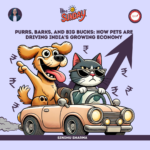By Abhishek Kwatra
Expectations:
- Increased allocation from the budget spending towards the textile sector.
- Budgetary allocation towards Amended Technology Upgradation Fund Scheme (ATUFS) was expected to increase.Under ATUFS, the garment manufacturing units get a subsidy of 25% for capital expenditures which was increased from 15% in Jan ’17 recently. Its budget allocation was reduced to Rs. 2013 Cr. from Rs. 2610 Cr.
- An export incentive scheme reducing duty costs, specifically for cotton products as cotton makes up for 90% of export demand.
Budget announcements
- Allocation to textile sector decreased marginally. It was reduced from Rs 6290 Cr. in 2016-17 to 6230 Cr. in 2017-18. Most of the spending on any other components of the budget was reduced due to overall lesser allocation of the budget which went against the industry expectation. This could be attributed to Rs. 6000 Cr. special package announced for textile sector in June ’16.
- Tax rate for SMEs (of annual turnover up to Rs 50 Cr. in 2015-16) has been reduced from 30 to 25%. Since more than 60% of the sector is unorganized, this will help improve the bottom line of the companies.
- The provision for textile infrastructure has been increased to Rs 1,860 Cr. in 2017-18 from Rs 506 Cr. in FY17. It will give a major boost to textile infrastructure by increasing the allocation for building textile parks, incubation facilities, processing and development centers.
- Lesser allocation of the budget towards Amended Technology Upgradation Fund Scheme(ATUFS). The allocation was reduced to Rs. 2013 Cr. in 2017-18 from Rs. 2610 Cr in 2016-17. This has been one of the major government schemes helping the manufacturing units to remain competitive upgrading their production facilities.
- Sharp reduction in allocation to price support scheme (Rs 0.01 Cr. in 2017-18 as against Rs 610 Cr. in 2016-17) under the Cotton Corporation of India (CCI) It may lead to greater volatility in cotton prices in next fiscal for the domestic companies. Cotton prices increased 66.6% in July’16 which forced many firms to reduce production. Firms have maintained a need for higher subsidies for cotton from CCI. This would greatly impact the bottom line of the companies.
- announced plans to launch a scheme for labor-intensive leather and footwear industry to boost employment generation. This announcement was in line with the special package of 6000 Cr. announced for textile sector in June’16 with an aim of increasing exports by $30 billion and help attract investment worth 74,000 Cr. in three years.
- Basic Custom Duty on Nylon mono filament yarn (for use in long line system for Tuna fishing only) reduced to 5% (from earlier 7.5%)
- The objective of doubling farmers’ income, skilling of youth, and development of Infrastructure. This would provide end to end solution by integrating rail, road, air and sea which in turn would greatly benefit the textile industry that is spread across the nation.
Market movement:
Companies have more or less maintained their price on Feb 3 since the announcement of budget on Feb 1. Companies such as Page industries, Arvind Ltd. and Raymonds Ltd. Were some of these. However, Vardhman Textiles defied the trend as it rallied by about 5% of its value.
Conclusion:
The budget did not meet the expectations of the textile industry. It ignored many important issues such as an export incentive scheme and raw material subsidies, specifically Cotton.
With already strong competition from Bangladesh and Vietnam, an export incentive scheme was the push that the sector needed as many firms had been able to cover their losses from domestic market owing to demonetization only due to stable export demand. Though the domestic demand would improve eventually, GST implementation needs to be implemented as soon as possible bringing in cost savings (outbound taxes) from the supply chain.

















Leave a comment